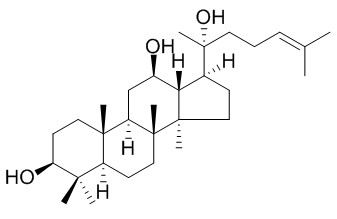(20R)-Protopanaxdiol
Protopanaxdiol is effective in preventing and healing obesity, fatty liver and hypertriglyceridemia in mice fed with a high-fat diet, it inhibits tumor interstitial microvascular density and its proliferation activity, finally inhibits tumor growth, it also inhibits expression of VEGF and bFGF protein. (20R)-Protopanaxdiol has protective effect on myocardial ischemia, which may be related to improving free radicals metabolism and myocardial metabolism, decreasing plasma TXA 2 levels.
Inquire / Order:
manager@chemfaces.com
Technical Inquiries:
service@chemfaces.com
Tel:
+86-27-84237783
Fax:
+86-27-84254680
Address:
1 Building, No. 83, CheCheng Rd., Wuhan Economic and Technological Development Zone, Wuhan, Hubei 430056, PRC
Providing storage is as stated on the product vial and the vial is kept tightly sealed, the product can be stored for up to
24 months(2-8C).
Wherever possible, you should prepare and use solutions on the same day. However, if you need to make up stock solutions in advance, we recommend that you store the solution as aliquots in tightly sealed vials at -20C. Generally, these will be useable for up to two weeks. Before use, and prior to opening the vial we recommend that you allow your product to equilibrate to room temperature for at least 1 hour.
Need more advice on solubility, usage and handling? Please email to: service@chemfaces.com
The packaging of the product may have turned upside down during transportation, resulting in the natural compounds adhering to the neck or cap of the vial. take the vial out of its packaging and gently shake to let the compounds fall to the bottom of the vial. for liquid products, centrifuge at 200-500 RPM to gather the liquid at the bottom of the vial. try to avoid loss or contamination during handling.
Polytechnic University of Catalonia2017, 105826
Appl. Sci. 2021, 11(10),4666.
mBio.2020, 11(3):e00686-20.
Agriculture.2024, 69(3):140-148.
Appl. Sci.2023, 13(17):9984.
Forensic Sci Int.2022, 341:111475.
Environ Toxicol.2021, doi: 10.1002
Antioxidants (Basel).2022, 11(12):2411.
Biochem Biophys Res Commun.2018, 505(4):1148-1153
Int J Mol Sci.2022, 23(23):14826.
Related and Featured Products
Fitoterapia. 2010 Dec;81(8):1079-87.
Anti-Obesity effects of protopanaxdiol types of Ginsenosides isolated from the leaves of American ginseng (Panax quinquefolius L.) in mice fed with a high-fat diet.[Pubmed:
20627120]
Effects of protopanaxdiol (PDG) and protopanaxatriol (PTG) types of ginsenosides isolated from the leaves of American ginseng on porcine pancreatic lipase activity were determined in vitro.
METHODS AND RESULTS:
PDG inhibited the pancreatic lipase activity in a dose-dependent manner at the concentrations of 0.25-1mg/ml. It inhibited hydrolysis of about 83.2% of triolein at about 1mg/ml of PDG. However, PTG showed no inhibitory activity. Therefore, anti-obesity activity of PDG was evaluated in mice fed a high-fat diet.
CONCLUSIONS:
The results demonstrated that PDG was effective in preventing and healing obesity, fatty liver and hypertriglyceridemia in mice fed with a high-fat diet.
J Ginseng Res. 2015 Jan;39(1):61-8
Molecular mechanism of protopanaxadiol saponin fraction-mediated anti-inflammatory actions.[Pubmed:
25535478]
Korean Red Ginseng (KRG) is a representative traditional herbal medicine with many different pharmacological properties including anticancer, anti-atherosclerosis, anti-diabetes, and anti-inflammatory activities. Only a few studies have explored the molecular mechanism of KRG-mediated anti-inflammatory activity.
METHODS AND RESULTS:
We investigated the anti-inflammatory mechanisms of the protopanaxadiol saponin fraction (PPD-SF) of KRG using in vitro and in vivo inflammatory models.
PPD-SF dose-dependently diminished the release of inflammatory mediators [nitric oxide (NO), tumor necrosis factor-α, and prostaglandin E2], and downregulated the mRNA expression of their corresponding genes (inducible NO synthase, tumor necrosis factor-α, and cyclooxygenase-2), without altering cell viability. The PPD-SF-mediated suppression of these events appeared to be regulated by a blockade of p38, c-Jun N-terminal kinase (JNK), and TANK (TRAF family member-associated NF-kappa-B activator)-binding kinase 1 (TBK1), which are linked to the activation of activating transcription factor 2 (ATF2) and interferon regulatory transcription factor 3 (IRF3). Moreover, this fraction also ameliorated HCl/ethanol/-induced gastritis via suppression of phospho-JNK2 levels.
CONCLUSIONS:
These results strongly suggest that the anti-inflammatory action of PPD-SF could be mediated by a reduction in the activation of p38-, JNK2-, and TANK-binding-kinase-1-linked pathways and their corresponding transcription factors (ATF2 and IRF3).
Journal of Chinese Pharmaceutical Sciences, 2002, 37(2):100-3.
Antimyocardial ischemic effects of Panax quinquefolium 20s-protopanaxdiol saponins (PQDS) and its mechanism[Reference:
WebLink]
To study the antimyocardial ischemic effects of Panax quinquefolium 20 s-protopanaxdiolsaponins (PQDS) extracted from the leaves of Panax quinquefolium and its mechanism.
METHODS AND RESULTS:
The changes of myocardial infarct size, the serum creatine phosphokinase(CK), lactate dehydrogenase (LDH), superoside dismutase(SOD), catalase(CAT) and glutathione peroxidase(GSH-Px) activity, the serum lipid peroxidation(LPO) and myocardial free fatty acid(FFA), lactic acid(LA) content and plasma prostacycline(PGI2) and thromboxane (TXA2) level were determined in rats with acute myocardial infarct model induced by ligating the left anterior descending coronary artery(LAD). After treated by PQDS(in a dosage of 12.5~50 mg · kg-1 iv at the same time of operation and 6 h later), the sizes of acute myocardial infarction were significantly reduced. The serum CK, LDH activity, the plasma TXA2 levels and myocardial FFA and LA contents were declined, while PGI2/TXA2 was increased significantly. In addition, serum LPO content was declined, SOD, CAT and GSH-Px levels were increased markedly.
CONCLUSIONS:
PQDS had protective effect on myocardial ischemia, which may be related to improving free radicals metabolism and myocardial metabolism, decreasing plasma TXA2 levels. Therefore, PQDS may be an effective drug for the treatment of myocardial ischemia.
Chinese Journal of Clinical Hepatology, 2008, 24(1):42-3.
Influences of Protopanaxdiol to vascular endothelial growth factor and basofibroblast growth factor protein expression of liver[Reference:
WebLink]
To discuss influences of Protopanaxdiol to vascular endothelial growth factor and basofibroblast growth factor protein expression of liver.
METHODS AND RESULTS:
To construct liver cancer animal models and the expermental animals are divided into five groups.Each group includes ten animals.That is control group,CTX group,Protopanaxdiol 25mg/kg,50mg/kg,100mg/kg groups.After two weeks,all the expertimental animals will be killed.We'll determine tumor volume and weight,then deal it into tissue spices for immunohistochemistry. In Protoanaxdiol groups,bFGF and VEGF protein expression is lower than that control group,its tumor volume and weight is lower distinguishly.
CONCLUSIONS:
It suggests that Ppd inhibites expression of VEGF and bFGF protein,finally inhibites tumor growth.



